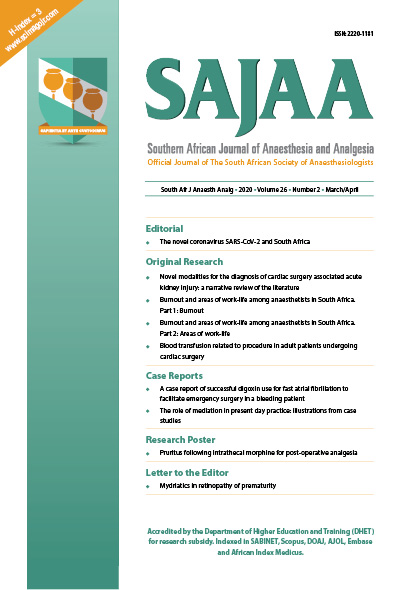The novel coronavirus SARS-CoV-2 and South Africa
Abstract
At the time of writing (27 March 2020), the novel betacoronavirus SARS-CoV-2 has infected 537 808 people, in 176 countries with 24 127 deaths and a mortality of 4.5%.1 South Africa is rapidly approaching a 1 000 confirmed cases, and has just entered ‘lockdown’ in an attempt to contain person to person transmission. SARS-CoV-2 belongs to the betacoronavirus family, which also includes severe acute respiratory syndrome coronavirus (SARS-CoV) and Middle East respiratory syndrome coronavirus (MERS-CoV).2 SARS-CoV-2 is spread by human to human droplet spread.3 The virus has a long period of survival on surfaces, and contact exposure is another major mechanism of spread. SARS-CoV-2 has also been identified for prolonged periods in faeces, exceeding 40 days in some patients.4 South Africa was one of the countries of highest risk of SARSCoV-2 importation in Africa,5 and has now swiftly moved to community transmission. South Africa has implemented the combined intervention of quarantining infected individuals, family members, school closure and workplace distancing which mathematically is the most effective means of decreasing person to person transmission, and the reproduction number (R0).6 SARS-CoV-2 has a R0 probably between 2 and 3.7 The resulting infectious disease of SARS-CoV-2 is known as COVID-19. In a report from Wuhan, China, the majority of patients had mild infections (84%). Sixteen per cent of patients had severe infections, and 6.1% of all patients required ventilation.2 In Lombardy, Italy, 12% of all positive cases required intensive care admission.8 Life-threatening complications exceeding one percent of all infected persons included severe acute respiratory syndrome, pneumonia, respiratory failure, and sepsis.2 It appears that patients with a marked cytokine and ‘hyperinflammation’ response to SARS-CoV-2 may be at increased risk of morbidity and mortality.9
Downloads
Published
Issue
Section
License
By submitting manuscripts to SAJAA, authors of original articles are assigning copyright to the SA Society of Anaesthesiologists. Authors may use their own work after publication without written permission, provided they acknowledge the original source. Individuals and academic institutions may freely copy and distribute articles published in SAJAA for educational and research purposes without obtaining permission.
The work is licensed under a Creative Commons Attribution-Non-Commercial Works 4.0 South Africa License. The SAJAA does not hold itself responsible for statements made by the authors.

